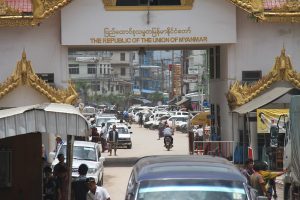More than 100 days after the Myanmar military’s coup d’etat, the fog is beginning to clear: the military’s State Administration Council (SAC) is in de facto control of the country, yet the economy is crippled and the junta is struggling to maintain stable relationships with its close neighbors. Indeed, despite the imposition of sanctions by the democracies of the West, the relationship between Myanmar’s junta and the governments in Beijing, Bangkok, and Delhi has become the latchkey, not just to the regime’s survival but also to a possible solution to the country’s political crisis.
In recent weeks, relations with China have come into relief. The SAC has re-organized its committees on implementing the China Myanmar Economic Corridor (CMEC) and approved two Chinese investments. In doing so, Naypyidaw has signaled to Beijing that the CMEC, a key pillar of Chinese engagement with Myanmar, is now on the agenda again after several months of political turmoil. Although Beijing is taking cautious steps to reengage with Naypyidaw, it doesn’t mean that it is in strategic hibernation.
While China has proactively engaged with regional actors to advance efforts aimed at resolving the political crisis through dialogue, some Chinese state-owned enterprises have planned for a major push on key CMEC infrastructure projects, including the planned China-Myanmar railway and special trade zones along the two countries’ long shared border. Overall, Beijing’s policy of supporting whichever government rules in Naypyidaw remains intact, though engaging with the military regime is no cup of tea due to the strong anti-Chinese sentiment that exists both within the Tatmadaw and the Myanmar public at large.
Since the coup, Beijing has prioritized the maintenance of stability along its border with Myanmar, and has enjoyed success to a certain extent, resulting in a majority of the ethnic armed organizations in northern Myanmar (though not all of them) maintaining ceasefires during these months of political upheaval.
In general, the love-hate relationship between Naypyidaw and Beijing remains, and whether or not relations improve may depend on Myanmar’s needs and its possible isolation from the west. But whether Beijing will protect the regime as it did for the previous military government in the 1990s and early 2000s remains an open question. If the situation continues to worsen, China could well push harder for a political settlement in order to maintain the political stability upon which its other strategic goals in Myanmar rely.
India is in a more difficult situation. Boasting both close contacts with the Tatmadaw and a position in the ascendant Quad grouping (which also includes the United States, Japan, and Australia), Delhi represents one of Naypyidaw’s few windows to the West. However, the coup and its aftermath have posed Delhi with a fresh challenge: namely, the armed struggles that have erupted in Chin State and northern Sagaing Region, close to the Indian border, as civilian militias have sought to carve out areas free from junta control. The stability and status quo in the border region are therefore now under threat.
With the high chance that this will result in an influx of small arms smuggling and competition for control over the area, the India-Myanmar border area could be the next conflict hotspot in Myanmar’s welter of decades-long armed conflicts, with the potential to spill over into India. Given its working relationship with the military, the Indian government’s priority may be the convening of an election that returns Myanmar to a (nominal) civilian administration as soon as possible. By removing the quota on bean and peas exports, Delhi has given Myanmar farmers a soft cushion, while keeping open most channels of engagement with the military government.
For the government in Bangkok, similarly, a resumption of armed conflicts, and the burden of accommodating the flow of refugees that has resulted, to say nothing of the risks of COVID-19 spreading into the country, has created no shortage of headaches.
In recent decades, Thailand has benefited from peace and stability along the border, and instability in Myanmar could have a massive impact that Thailand can’t afford. Be maintaining and renewing its investment in the country, Bangkok is making a statement that avoiding conflicts and keeping business on track is its main priority. The government of Prime Minister Prayut Chan-o-cha doesn’t want conflict to spread the conflict along the border, as in the 1990s, and has clearly stated its the position to the leaders of EAOs controlling zones close to the Thai border. This may create tensions within these armed groups, as to whether to allow their territories to be used as the launch pad for a new wave of armed struggle.
Much about the immediate future remains unclear, but unlike the 1990s, Beijing, Delhi, and Bangkok can’t afford a resumption of serious armed conflict along their borders with Myanmar; neither do they want a failed state at their back door. All therefore have a strong incentive for helping resolve the crisis in Myanmar, though the extent to which they manage to do so remains to be seen.

































